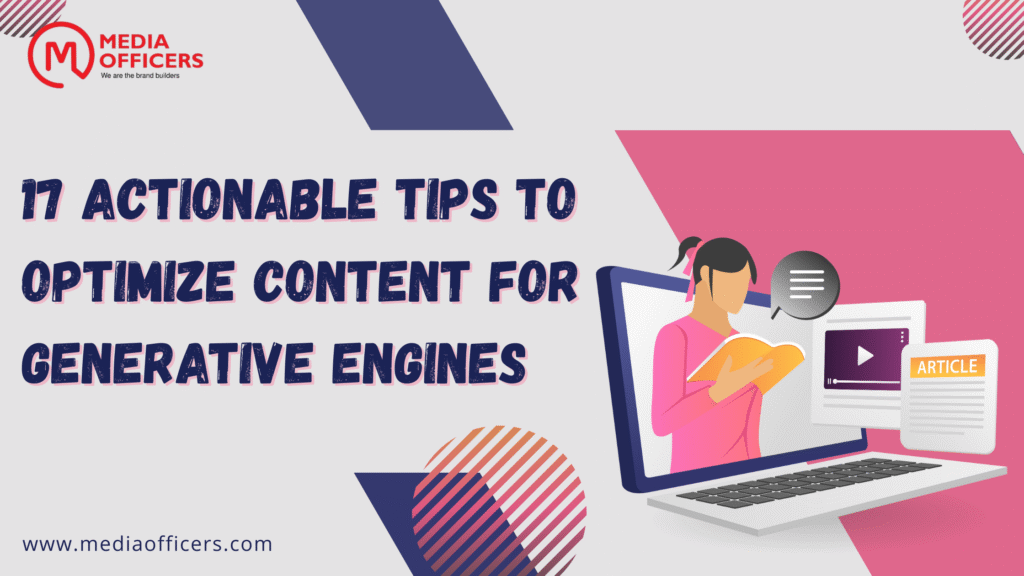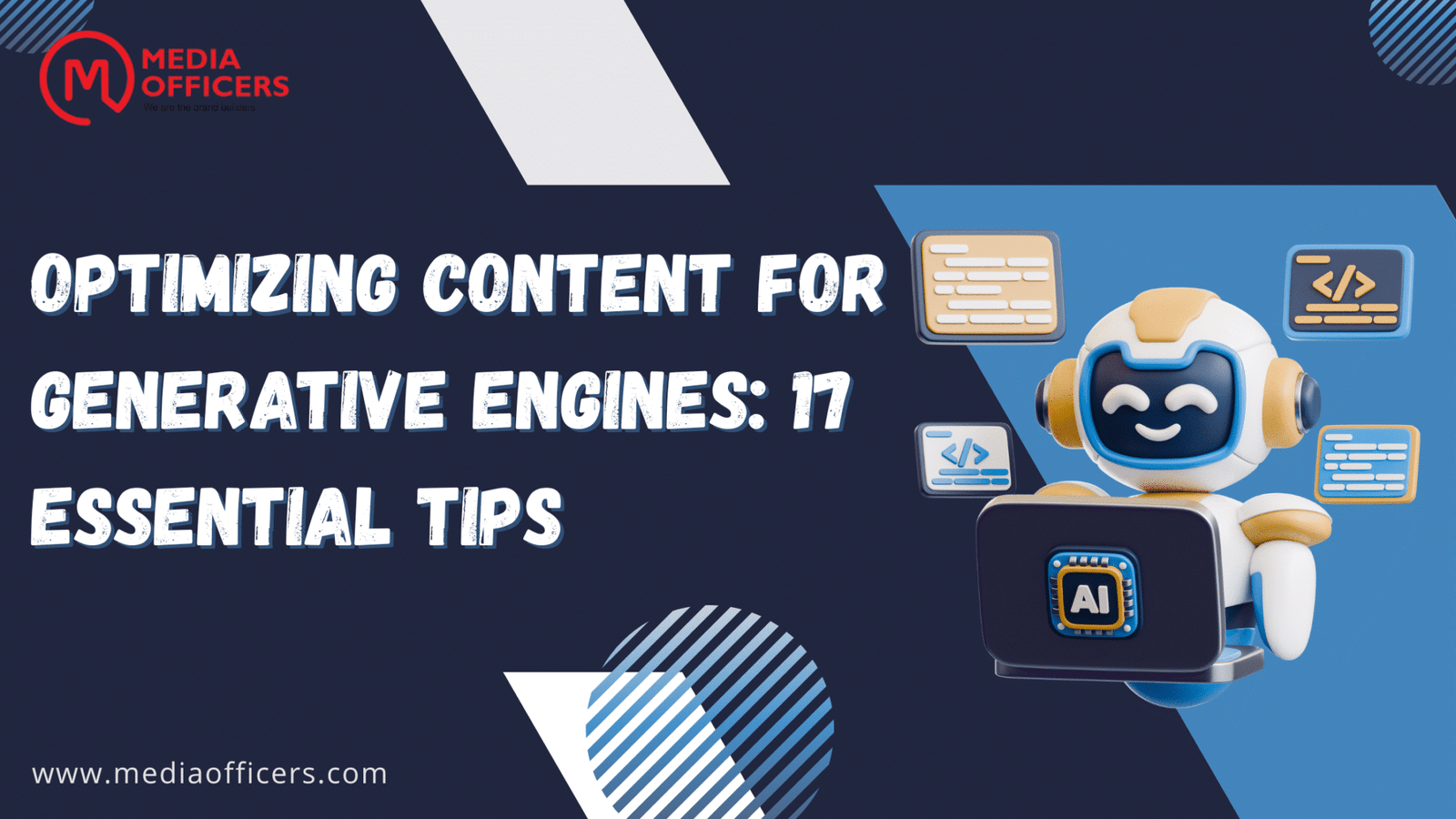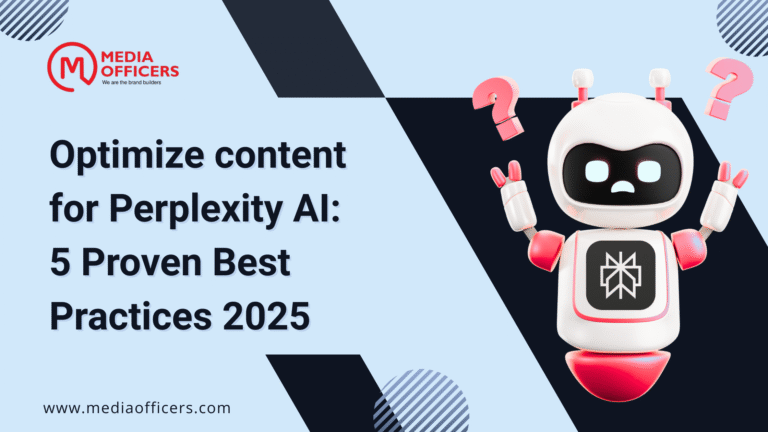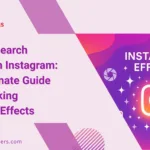Optimizing content for generative engines is a practical discipline that blends traditional SEO with AI-first ranking signals. As AI summaries become the starting point for many queries, publishers must craft pages that satisfy both models and human readers.
In this guide, we explore how to design, publish, and maintain content so it can be found, cited, and trusted by AI-powered search experiences and by users who want depth, proof, or tools.
17 actionable tips to optimize content for generative engines

Lead with the answer, then earn the click
For this tip on fast comprehension, Optimizing content for generative engines means presenting a clear, verifiable summary first. Open with a concise TL;DR that a model can quote, then follow with deeper nuance, examples, and tools for humans who want to dig in.
Keep the overview tight about 100–180 words with two high-quality sources anchored to primary data. This structure helps AI summaries and human readers alike.
Make every claim easy to cite
For this tip on credibility, Optimizing content for generative engines requires atomic facts with transparent attribution. When you present statistics or quotes under three years old, link to the primary source and ensure the citation is obvious in the page structure.
Provide direct pointers to original research rather than roundup compilations. Label numbers clearly, and use data visualization where helpful to improve trust signals.
Organize pages around questions and tasks
For this tip on user intent, Optimizing content for generative engines benefits from question-based subheads and task-oriented flows. Map headings to the exact follow-up questions readers naturally ask in AI contexts.
Convert long sections into approachable Q&A blocks and step-by-step checklists that readers can skim quickly and then dive deeper into when needed.
Show your credibility
For this tip on trust, Optimizing content for generative engines works best when author authority, editorial process, and data sources are visible. Bylines, bios, publication dates, and a clear methodology all bolster confidence in both models and humans.
Include a short section on how you researched and tested claims. This transparency often leads to better sourcing and higher citations from AI-friendly experiences.
Use structured data to express facts
For this tip on clarity, Optimizing content for generative engines benefits from solid structured data. While there is no special schema just for AI Overviews, adding Article markup and relevant schema types helps search engines understand your content more precisely.
Apply HowTo, FAQPage, or Product schema where applicable. Even modest structured data can correlate with stronger visibility and AI-grounded citations.
Keep content indexable, fast, and free of blockers
For this tip on performance, Optimizing content for generative engines requires accessible, fast-loading pages. Slow or script-heavy content hurts retrieval and model comprehension.
Follow Core Web Vitals, ship server-rendered HTML for core content, and minimize render-blocking JS. Remove intrusive interstitials and ensure all essential information loads quickly.
Write for two reading modes
For this tip on readability, Optimizing content for generative engines means offering a tight overview for scanners and a deeper dive for evaluators. A table of contents supports fast jumps and guides readers toward the deeper sections a model might reference.
Provide a key takeaways section after the intro and expandable sections for details to accommodate different reading behaviors.
Refresh with intent, not just a date bump
For this tip on relevance, Optimizing content for generative engines require updates when guidance, prices, or features change. Substantive changes outrun mere date updates and help maintain AI-driven visibility.
Maintain a change log at the end of evergreen posts, clearly calling out what changed and why. Track volatility by query to spot churn early.
Turn comparisons into criteria-based tables
For this tip on clarity, Optimizing content for generative engines benefits from tables that list criteria, thresholds, and target audiences. People and models both parse tables more easily than prose when evaluating options.
When you cite numbers, link to primary specs or tests. Include a short block like a “How we chose” guide that summarizes the decision rules used.
Create short, canonical definitions for key entities
For this tip on precision, Optimizing content for generative engines thrives on mini glossaries. Short, clean definitions of terms, models, or frameworks are more likely to be quoted by AI systems.
Place definitions where terms first appear and collect them in a glossary at the end for easy reference and linking opportunities.
Win where AI engines shop for sources
For this tip on sourcing, Optimizing content for generative engines hinges on being a trusted, high-ranking page. AI copilots intentionally surface sources that are credible and well-ranked.
Monitor queries in both Google and Bing, and close gaps that block generative visibility. Strong classic SEO tends to translate into AI visibility.
Seed the next logical follow-ups
For this tip on progression, optimizing content for generative engines benefits from ending sections with prompts for what to ask next. This aligns with AI Mode query fans and increases the usefulness of your page in multistep journeys.
After each major section, include two to three suggested follow-up questions to improve long-tail resonance.
Target jobs to be done
For this tip on purpose, optimizing content for generative engines should map to the tasks readers want to accomplish. Include prerequisites, potential pitfalls, and realistic timelines to support decision-making.
Offer checklists and a first-week plan for implementations to help readers move from evaluation to action quickly.
Publish original data and demonstrations
For this tip on originality, Optimizing content for generative engines rewards pages that publish the underlying data and demonstrations. Original benchmarks and visuals position you as a primary source for AI-grounded citations.
Release a quarterly data set or a small test with raw figures and explain your methodology. Link to the raw data for researchers and tools.
Add video where a demo beats text
For this tip on demonstration, Optimizing content for generative engines benefits from video evidence. Short explainers or live demos with clear labeling help AI systems cite and users verify.
Embed the video on the canonical page, align titles and captions, and attach consistent schema to improve discoverability across AI experiences.
Build topic clusters, not one-off posts
For this tip on resilience, Optimizing content for generative engines performs best when you build topic clusters. A pillar page plus four to six supporting assets answers varied jobs to be done and creates a robust internal link structure.
Note that AI Overviews churn often, so clusters provide stability and more chances for citation across related queries.
Measure what matters beyond raw clicks
For this tip on metrics, optimizing content for generative engines requires visibility beyond simple clicks. Track AI Overview presence, Copilot and Perplexity references, assisted conversions, and brand query growth.
Use a weekly visibility board to monitor which pages are cited, by which AI, and how often the citations change. Segment analytics for AI referrals to understand impact.
Integrate a canonical page with a clear update cadence
For this tip on governance, Optimizing content for generative engines benefits from a dedicated canonical page that remains consistent while updating related sections. This balance helps AI keep the core message stable while indexing fresh signals.
Document updates in a changelog, and ensure all revisions preserve structured data and accessibility.
Optimize for accessibility and inclusivity
For this tip on broad reach, Optimizing content for generative engines must appear accessible to diverse readers and assistive technologies. Use descriptive headings, alt text, and clear language to widen reach and trust.
Accessibility improvements also support consistent crawling and indexing by AI systems that value inclusive content.
Leverage internal links to reinforce authority
For this tip on site structure, Optimizing content for generative engines benefits from thoughtful internal linking. Link from pillar pages to supporting assets and from those assets back to the core pillar to distribute value.
Strong internal linking helps both humans and AI find related content quickly and improves the chances of being cited by AI references.
Audit and prune low-value signals
For this tip on efficiency, Optimizing content for generative engines requires regular audits. Remove outdated or low-signal pages that distract crawlers and dilute topical authority.
Focus resources on high-potential pages and ensure that every piece supports a clear job to be done.
Foster community signals and user trust
For this tip on engagement, Optimizing content for generative engines benefits when readers leave favorable signals comments, reviews, and social proofs that reinforce authority.
Encourage thoughtful engagement and respond to feedback to strengthen trust and citations from AI experiences.
Plan for multilingual and international reach
For this tip on expansion, Optimizing content for generative engines should consider global audiences. Publish language-specific pages with proper hreflang annotations and localized data when relevant.
Well-structured international content increases the chance of AI models citing you across regions.
Frequently Askeded Questions
What does Optimizing content for generative engines really mean in practice?
In practice, it means designing pages that deliver a clear, citable answer first, then offering depth, context, and tools. It blends high-quality editorial standards with AI-ready structure so models can quote you accurately while users get value.
How often should I update AI-facing content?
Update when there are substantive changes to guidance, data, or features. Track volatility over time and maintain a changelog so both readers and AI experiences see when and why updates occurred.
What role does structured data play in AI visibility?
Structured data helps search engines understand your content’s meaning and relationships. While it isn’t a magic button for AI Overviews, it correlates with better organic visibility and more reliable citations from AI experiences.
Can I measure AI-driven visibility independently from traditional metrics?
Yes. Track AI Overviews, Copilot and Perplexity references, and cross-channel signals. Combine this with classic metrics like time on page and assisted conversions to get a complete view of impact.
Conclusion: By applying Optimizing content for generative engines practices clear summaries, precise citations, and a robust topic cluster strategy you can achieve visibility in both traditional search and AI-driven experiences. The landscape is dynamic, but a disciplined, transparent approach builds trust with readers and with machines alike. The goal is not just to rank, but to be a reliable source that AI models want to cite and humans want to read. Optimizing content for generative engines is a long-term strategy, and the payoff is stronger, more durable search presence.








